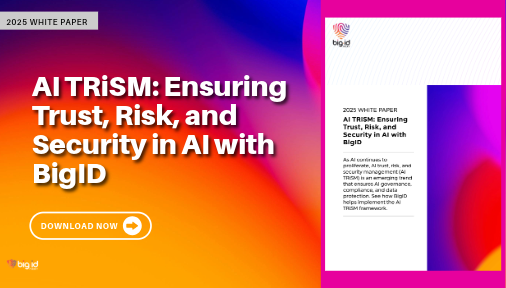The Importance & Benefits of an AI-Ready Data Inventory
Why knowing your data—deeply and continuously—will define enterprise success and security in 2026.
Key Highlights
- AI accelerates productivity, but it also amplifies data risk.
- An AI-ready data inventory gives organizations the visibility needed to govern, secure, and responsibly scale AI.
- Knowing what data you have, where it lives, and how it’s classified is the prerequisite to safely using AI without exposing sensitive enterprise information.
- In 2026, the organizations that win with AI will be those that treat data discovery, classification, and governance as strategic investments—not technical chores.
- BigID stands out for delivering automated discovery, deep classification, and AI-specific metadata that teams need to operationalize trusted AI.
What is an “AI-Ready Data Inventory”?
Definition & Scope
An AI-Ready Data Inventory is a structured, maintained asset that captures:
- All data assets that are (or could be) used in AI/ML workflows (training sets, inference data, prompts, logs).
- Where each resides (cloud, on-premises, SaaS, data lake, data warehouse).
- Metadata: owner/custodian, sensitivity classification, retention requirements, compliance/legal context, linkage to purpose/use-case.
- How data flows into, through and out of AI systems (ingestion, transformation, model training, endpoint inference, feedback loops).
- Controls applied (access rights, encryption, label/classification, logging/monitoring).
Why an AI-Ready Data Inventory Matters Now
AI systems—especially generative AI—consume massive, diverse, and often sensitive datasets. Without an accurate inventory, organizations risk:
- leaking confidential information into AI models
- using regulated data in unapproved AI workflows
- losing visibility into training, inference, and retention pipelines
- failing audits due to missing or outdated metadata
- enabling shadow AI and unmonitored data flows
The traditional “data catalog + policies” approach is no longer enough. AI introduces new data behaviors, new exposure paths, and new regulatory expectations.
To protect modern AI pipelines, you need a real-time, auto-updated, deeply classified inventory—the foundation of every downstream security and governance control.
AI Data Inventory vs AI Data Catalog
| Feature | AI Data Inventory | AI Data Catalog |
|---|---|---|
| Primary Focus | Secure mapping: what data exists, where, how classified, risk-profile | Discovery and semantic mapping for business users: datasets, lineage, usage |
| Governance Emphasis | High (security, compliance, AI-risk) | Moderate (metadata, business context, usability) |
| Audience | CISOs, CDOs, CPOs, Data-Governance/Privacy teams | Data analysts, data scientists, business stakeholders |
| Typical Content | Resource location, sensitivity labels, retention, risk flags, AI workflows | Dataset descriptions, tags, business glossaries, data relationships, usage patterns |
| Use-cases | Inventory for AI readiness, risk-assessment, regulatory audit, least-privilege controls | Self-service analytics, data democratization, lineage tracking, catalog search |
| Relationship | Inventory → Catalog: inventory underpins catalog | Relies on inventory to feed accurate metadata & lineage |
Benefits of Building an AI-Ready Data Inventory
1. AI-Driven Risk Reduction
A complete understanding of your data allows you to quickly identify:
- sensitive or regulated data entering model training
- personal, financial, or proprietary information appearing in prompts
- high-risk data locations, shadow datasets, or stale training artifacts
- excessive access privileges to AI-feeding datasets
This visibility directly reduces the likelihood of breaches, leakage, and compliance violations.
2. Faster AI Adoption With Lower Friction
Teams move faster when they know what data exists and whether it’s trustworthy.
An AI-ready inventory provides:
- clean, high-quality datasets for AI/ML initiatives
- automated classification that eliminates manual prep
- confidence that data meets compliance before it feeds a model
The result: safer innovation at scale.
3. Strengthened Data Governance for AI
AI requires context, not just metadata.
An inventory enriched with AI-specific insights—such as training lineage, inference logs, and model-dataset permissions—dramatically improves:
- transparency
- auditability
- ethical oversight
- explainability
This is the governance foundation regulators are already expecting.
4. Operational Efficiency Across Security, Privacy & Data Teams
When everyone works from a shared source of truth, organizations reduce:
- duplicate datasets
- redundant model training
- costly misclassification
- engineering time spent searching for or validating data
An AI-ready inventory aligns CISO, CDO, and CPO priorities into one strategy.
What’s New in 2026?
AI adoption is accelerating, but so is regulatory pressure. Organizations will need:
AI-specific data classification
Not just sensitive vs non-sensitive—but classification for:
- training eligibility
- inference-only data
- retention requirements
- regulatory purpose
- model-exposure risk
Real-time lineage & AI workflow mapping
Understanding:
- which datasets train which models
- how data transforms between steps
- when data flows across cloud, SaaS, or third parties
Continuous monitoring & DSPM for AI systems
2026 introduces the expectation of continuous oversight—not periodic audits.
Governance tied to model behavior
Data governance will evolve into model governance, requiring inventories that map:
- dataset influence
- model drift
- data quality changes
- bias or sensitivity fluctuations
BigID already supports this direction with automated discovery, classification, DSPM insights, and AI-specific data context.
How to Build an AI-Ready Data Inventory
Below is a practical, action-ready approach.
Step 1: Discover All Data Across Your Ecosystem
Use automated scanning to identify data across:
- cloud storage
- SaaS platforms
- on-prem systems
- data lakes/lakehouses
- collaboration tools
- model training/inference logs
Manual reporting won’t scale—automation is mandatory.
Step 2: Classify Data for Sensitivity and AI Use
Traditional classification is no longer enough.
You need labels such as:
- PII / PHI / PCI
- Highly Confidential
- AI-Eligible Training Data
- Inference-Only
- Restricted for GenAI
- Regulatory-Bound Data
BigID’s ML-based classification provides this level of precision at scale.
Step 3: Map Data Flows Into AI Systems
Document:
- data sources
- transformations
- training pipelines
- inference endpoints
- model storage and logging
This prevents shadow AI and ensures oversight.
Step 4: Implement AI-Aware Access Controls
Limit access to datasets based on:
- sensitivity
- AI training eligibility
- business purpose
- user role
- risk score
Add guardrails like prompt-filtering, DLP, token-level controls, and model-output monitoring.
Step 5: Continuously Monitor & Update the Inventory
An AI-ready inventory must be dynamic, not static.
Set alerts for:
- newly discovered datasets
- data drifting into the wrong AI workflows
- model outputs using restricted data
- policy violations
- abnormal access patterns
BigID’s DSPM capabilities automate much of this.
Build a Trusted, AI-Ready Data Inventory with BigID
BigID gives organizations everything they need to build an AI-ready data inventory:
- Automated data discovery across all environments
- Deep ML-driven classification for AI-sensitive data
- DSPM visibility across cloud, SaaS, and models
- AI-specific metadata and lineage mapping
- Continuous monitoring and governance controls
Organizations use BigID to:
- prevent data leakage into generative AI
- enforce policy compliance before data enters training pipelines
- validate the provenance and quality of training data
- give CISOs, CDOs, and CPOs a unified view of AI-data risk
BigID reduces risk while accelerating responsible AI innovation.
If you want to responsibly scale AI without compromising your enterprise’s most valuable asset—its data—start building your AI-ready data inventory today. The sooner you begin, the safer and more successful your AI initiatives will be. Schedule 1:1 demo with our experts.



